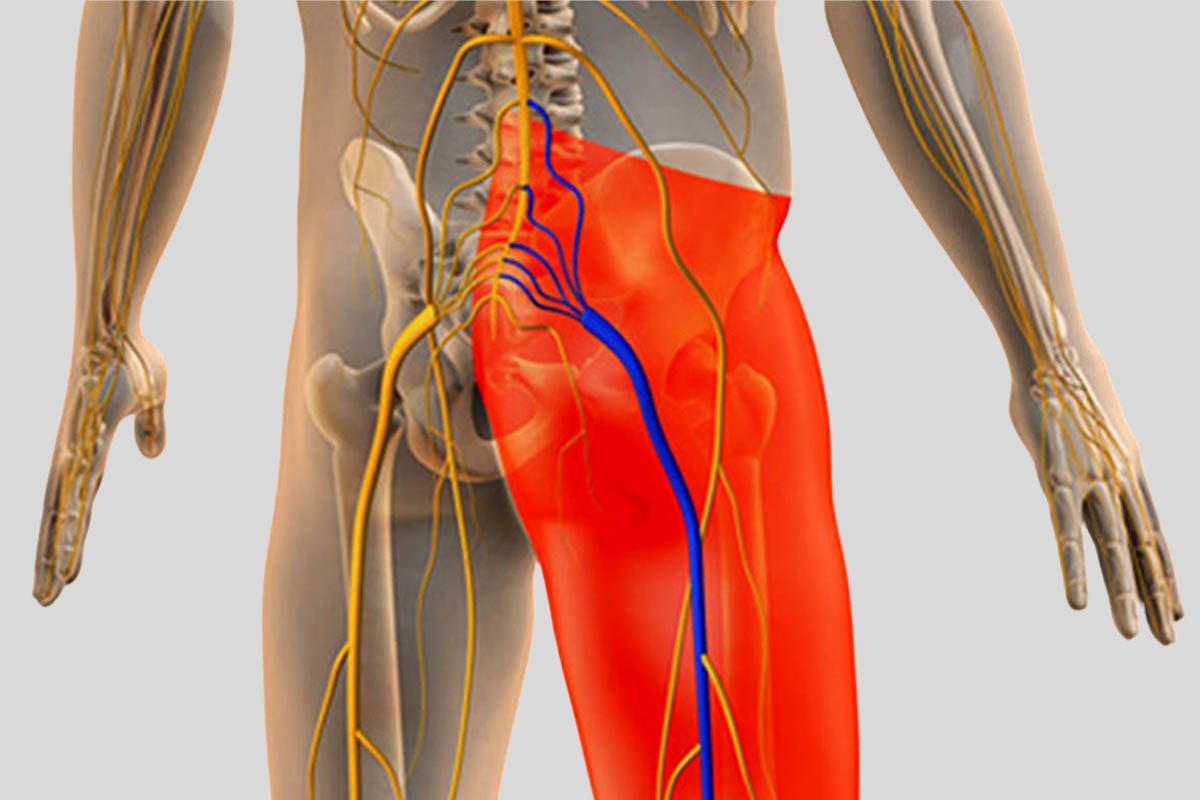Many people experience sciatica and hip pain, often wondering, “Can sciatica cause hip pain?” or “Does sciatica cause hip pain?” The answer is yes – hip pain from sciatica is a common issue that can affect mobility and quality of life. Sciatica occurs when the sciatic nerve, the body’s longest nerve, becomes compressed or irritated. This can result in radiating pain that starts in the lower back and travels down the leg, oftentimes settling in the hip. In this article, we’ll explore what sciatica is, how it relates to hip pain, and the signs, causes, and treatment options available for those suffering from this chronic (long-term) pain.
What is Sciatica?
Sciatica is a condition resulting from irritation or compression of the sciatic nerve, a large nerve that runs from the lower back, through the hips, and down each leg. When this nerve becomes compressed due to issues such as a herniated disc, spinal stenosis, or disk slippage, it can cause pain along its pathway, including the hip.
Sciatica is a widespread, yet often misdiagnosed, condition affecting a significant portion of the population. Studies suggest that nearly 40% of people will experience sciatica at some point in their lives, with its likelihood increasing as people age. This pain can vary in severity, from mild discomfort to chronic, debilitating pain, and understanding it better can help in managing and reducing its impact.
How Sciatica Can Cause Hip Pain
The sciatic nerve passes through the hip region, meaning any compression or irritation along this nerve can lead to hip pain. Conditions like herniated discs or spinal stenosis can pinch the nerve, leading to a variety of painful symptoms, including hip pain. Additionally, piriformis syndrome, which involves the piriformis muscle compressing the sciatic nerve, can cause hip pain that mimics sciatica.
Other Causes of Hip Pain to Consider
While hip pain from sciatica is common, several other causes could be responsible. Here are a few potential sources of hip pain:
- Arthritis: Degenerative conditions like arthritis can lead to joint pain, often mistaken for sciatica-related hip pain.
- Bursitis: Inflammation in the hip joint’s connective tissue sacs, called bursae, may lead to hip pain, especially during movement.
- Hip labral tear: Tears in the connective tissue of the hip joint can result in deep pain.
- Tendonitis: Inflammation of hip tendons due to overuse or strain can also cause hip discomfort.
Distinguishing between these causes and sciatica can be difficult, which is why consulting a healthcare professional is often necessary.
Signs and Symptoms of Sciatica-Related Hip Pain

Recognizing the signs of sciatica-related hip pain is crucial for identifying the right treatment path. Sciatica pain has distinct characteristics, but since it can mimic other conditions, understanding these specific symptoms helps differentiate it from other types of hip pain. Below are the common symptoms associated with sciatica-related hip pain to help you better understand and assess your experience.
Varied Pain Levels
Sciatica pain can vary from mild discomfort to severe, chronic (long-term) pain. Hip pain from sciatica may start as an ache and progress to more intense, debilitating pain.
Burning Sensation or Electric Shock-Like Pain
Sciatic pain is often described as a burning or electric shock sensation that travels down the leg. This radiating pain may begin in the lower back, affect the hip, and continue down the sciatic nerve, leading to sensations that are hard to ignore.
Numbness and Tingling
Sciatica often causes numbness or tingling, commonly referred to as a “pins and needles” sensation. This feeling can affect the hip, buttocks, or leg, as well as the foot, due to sciatic nerve dysfunction.
Pain Aggravated by Certain Actions
Certain activities, like prolonged sitting or movements such as bending, twisting, or lifting, may aggravate sciatica-related hip pain. Even low-impact actions, like walking or getting up from a chair, can intensify the discomfort.
Sharp, Shooting Pain Along the Sciatic Nerve
Sharp, shooting pain that travels along the sciatic nerve is one of the main indicators of sciatica. This pain often originates in the lumbar spine and may radiate down the leg, making it challenging to walk or move without discomfort.
How to Tell if Hip Pain is Sciatica-Related
Identifying whether hip pain is caused by sciatica involves understanding the symptoms and consulting a healthcare provider. Medical evaluations like MRI scans, CT scans, or diagnostic assays can reveal spinal issues such as herniated discs or spinal stenosis that may be responsible. Additionally, specialized tests, such as the straight-leg test, are tests that can be conducted by a physical therapist, which can help identify a sciatic nerve problem without the need for costly imaging procedures. A healthcare provider will also review your medical history to assess underlying risk factors.
Treatment Options for Sciatica Hip Pain
Effectively managing sciatica-related hip pain often requires a combination of treatments, including physical therapy and manual therapy, tailored to alleviate discomfort and address the root cause of the nerve compression. From self-care practices to medical interventions, there are numerous approaches available to relieve pain and improve mobility. Here are some of the most common treatment options for sciatica hip pain, ranging from home remedies to advanced medical therapies.
Ice or Heat Therapy
Alternating between ice and heat therapy can reduce inflammation and ease muscular spasms. Applying an ice pack to the affected area helps decrease inflammation in the early stages of the injury, while heat can relax muscles and improve blood flow.
Non-Steroidal Anti-Inflammatory Drugs (NSAIDs)

NSAIDs, such as ibuprofen, can help reduce pain and inflammation. These medications are often effective in reducing symptoms and can be part of a comprehensive treatment plan.
Physical Therapy
Physical therapy focuses on strengthening muscles around the spine and hips to support the body’s ability to maintain neutral position and optimal movement of the spine, hips, knees, ankles, and feet; to allow for the sciatic nerve to function like it normally should. Exercises designed to build core strength and flexibility can alleviate pressure on the sciatic nerve and reduce pain over time. Physical therapy may also include guidance on posture and movement modification to prevent re-injury and recurrence of sciatic nerve issues.
Research underscores the importance of addressing sciatic nerve pain promptly, with several studies highlighting positive outcomes when physical therapy is initiated early. These studies have shown that starting some form of physical therapy for sciatica can significantly improve pain levels, mobility, and overall recovery, helping to prevent chronic pain from developing.
Corticosteroid Oral Medication
Corticosteroid or epidural injections are sometimes recommended to reduce inflammation near the sciatic nerve. These injections can provide temporary relief and may improve the effectiveness of other therapies, like physical therapy.
Prevention Tips
Preventing sciatica and related hip pain is achievable through lifestyle adjustments and specific exercises aimed at supporting spinal health. Maintaining a healthy weight can help reduce pressure on the lumbar spine, while practicing good posture, especially during prolonged sitting, can prevent unnecessary nerve compression. Engaging in aerobic exercise and low-impact activities strengthens the body and enhances flexibility, which helps safeguard against sciatica. Additionally, building core strength and flexibility further supports the spine and hips, reducing the risk of nerve irritation. For added safety, installing grab bars and stair rails can offer extra support around the home and aid in fall prevention.
When to Seek Medical Help
While mild sciatica can often be managed at home, persistent or severe cases warrant professional evaluation. Seek medical attention if your pain doesn’t improve or is accompanied by muscle weakness, loss of bladder or bowel control, or symptoms of cauda equina syndrome, as these can indicate serious complications.
How Austin Manual Therapy Associates Can Help
At Austin Manual Therapy, we specialize in effective, personalized solutions for managing sciatica-related hip pain. Our expert team provides advanced physical therapy and manual therapy techniques to alleviate pain, restore mobility, and address the root causes of nerve compression. Using evidence-based treatments and hands-on care, Austin Manual Therapy tailors each approach to meet the unique needs of our clients, promoting long-term relief and enhanced quality of life. Whether you’re dealing with chronic sciatica pain or an acute flare-up, our skilled therapists are here to help you regain comfort and control over your movement.
Austin Manual Therapy Associates specializes in treating sciatica and hip pain through spinal orthopedic therapy and manual techniques. They design customized treatment plans involving sciatica physical therapy, flexibility training, and muscle strengthening exercises. Their expertise in managing spinal dysfunction and nerve-related conditions ensures a comprehensive approach to improving both mobility and quality of life.
Conclusion
Sciatica-related hip pain can be managed with a combination of lifestyle modifications, therapeutic exercises, and, in some cases, medical interventions. Understanding the causes, symptoms, and treatment options for hip pain from sciatica allows you to make informed decisions and take control of your health. For those seeking relief and a proactive approach to managing pain, working with experts, like the team at Austin Manual Therapy Associates, offers a promising path toward recovery.
FAQs
How do I know if my hip pain is sciatica?
If your hip pain starts in the lower back, radiates through the buttocks, and sometimes feels like an electric shock sensation, it’s likely due to sciatic nerve irritation. You may also experience numbness, tingling, or pins and needles in the affected leg. Consulting a healthcare provider and undergoing diagnostic tests, such as a CT scan, MRI, or electromyography, can confirm the diagnosis.
How do you release sciatic pain in your hip?
Sciatica pain can be alleviated through physical therapy, which is designed to improve sciatic nerve function, flexibility, and core strength can also be beneficial. Additionally, pain relief methods like non-steroidal anti-inflammatory drugs and epidural injections can help manage pain.
What can be mistaken for sciatica pain?
Other conditions can mimic sciatica pain, such as piriformis syndrome, hip bursitis, degenerative joint disease, or spinal tumors. These conditions often have overlapping symptoms, such as radiating pain or hip discomfort. Proper diagnostic tests, including MRI, CT scans, and diagnostic assays, can help differentiate sciatica from other conditions.





